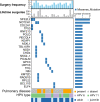Comprehensive multiomic characterization of human papillomavirus-driven recurrent respiratory papillomatosis reveals distinct molecular subtypes
- PMID: 34931021
- PMCID: PMC8688513
- DOI: 10.1038/s42003-021-02942-0
Comprehensive multiomic characterization of human papillomavirus-driven recurrent respiratory papillomatosis reveals distinct molecular subtypes
Abstract
Recurrent respiratory papillomatosis (RRP) is a debilitating neoplastic disorder of the upper aerodigestive tract caused by chronic infection with low-risk human papillomavirus types 6 or 11. Patients with severe RRP can require hundreds of lifetime surgeries to control their disease and pulmonary papillomatosis can be fatal. Here we report the comprehensive genomic and transcriptomic characterization of respiratory papillomas. We discovered and characterized distinct subtypes with transcriptional resemblance to either a basal or differentiated cell state that associate with disease aggressiveness and differ in key molecular, immune and APOBEC mutagenesis profiles. Through integrated comparison with high-risk HPV-associated head and neck squamous cell carcinoma, our analysis revealed divergent molecular and immune papilloma subtypes that form independent of underlying genomic alterations. Cumulatively our results support the development of dysregulated cellular proliferation and suppressed anti-viral immunity through distinct programs of squamous cell differentiation and associated expression of low-risk HPV genes. These analyses provide insight into the pathogenesis of respiratory papillomas and provide a foundation for the development of therapeutic strategies.
© 2021. This is a U.S. government work and not under copyright protection in the U.S.; foreign copyright protection may apply.
Conflict of interest statement
The authors declare no competing interests.
Figures







References
-
- Artemchuk H, et al. Seroprevalences of antibodies to 11 human papillomavirus (HPV) types mark cumulative HPV exposure. J. Infect. Dis. 2018;218:398–405. - PubMed
Publication types
MeSH terms
Supplementary concepts
LinkOut - more resources
Full Text Sources

